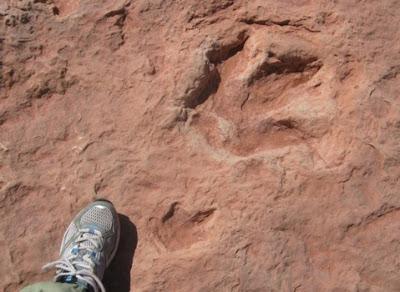
Theropod (perhaps Dilophosaurus) tracks near Tuba City, Arizona
My friend and fellow children’s book writer Caroline Hatton saw these dinosaur tracks in March of 2016 when she was on a trip to Arizona.Tuba City is within the Painted Desert at the western edge of the Navajo Nation
Our guide’s name was Bertha. I think. I’m not sure, because even though she was shouting, the wind was screaming louder. It was blasting us—sandblasting us. Violent gusts slapped us around, deafening, blinding, asphyxiating!
I had read about dinosaur tracks off U.S. Highway 160, about five miles west of Tuba City, Arizona. Hand-painted signs showed where to turn off the highway, park, and meet a guide. Tours were free and donations appreciated. The minimal jewelry stands were empty because of the dust storm.

Dinosaur trackway. Can you see the village near the mesa! Me neither.
With the wind shaking the car and the desert landscape visible only once in a while when dust didn’t fill the air, getting a guide sounded better than wandering off into a sandstorm searching for dinosaur tracks with no idea where to look.Our guide walked a few steps away from the car and pointed down. Three-toed footprints raced away and every which way, deeply pressed into flat pink rock.The footprints had formed after the dinosaurs walked in mud tens of millions of year ago, and the mud later hardened and became rock. Fossil footprints fall in the category of trace fossils or ichnofossils, as opposed to fossilized body parts.
The dinosaurs who left these three-toed tracks belonged to a group called theropods, meat-eaters who walked on two legs. The best-known member is T. rex (Tyrannosaurus rex) but there are many species. The dinos who had stomped all over the spot where we now stood may have been Dilophosaurus. Even experts can’t tell from the tracks because they do not have enough information.
One set of tracks showed a pair of dinoraptors had walked together, one bigger than the other, perhaps male and female.

Tracks of small and extra small raptors—perhaps a mom and baby?

Four-toed dinosaur track
As our guide moved on, she shared how she grew up “there” (between us and a low plateau or mesa on the horizon, where we could barely make out village dwellings during short bursts of visibility). As a little girl, she walked past these tracks every day on her way to the school bus stop. Her mom decided to find out what they were. After she did, she started offering tours. Bertha came along and learned how to do it, beginning at age five. And today Bertha’s five-year-old granddaughter tagged along with us.
The interpretation of some features was best left to the imagination. What were the stone balls embedded in the rock: dinosaur egg yolks, other parts too fierce to mention, or mineral formations?

What could these be?
I took the photos in this article with an eight-year-old Canon Powershot that had long had sporadic difficulties with the lens extension and retraction mechanism. The replacement cover for the battery-and-chip compartment had recently become increasingly temperamental. I kept my back squarely to the wind, the Powershot under my jacket, and tried to minimize how long I whipped out the camera to snap photos.
But the adventure proved fatal to both the lens mechanism and battery-compartment cover. A repair guru removed the chip surgically to save the photos, then declared the camera defunct—uncleanable. Too bad, but after all, no one knows how soon the camera would have croaked anyway. So it is now extinct, just like the dinosaurs whose tracks we followed in Arizona.
For more info:
See a Dilophosaurusskeleton and artist’s visions at “Dilophosaurus!”An exhibition narrated by its discoverer, the late Sam Welles, formerly a professor at the University of California Museum of Paleontology: http://www.ucmp.berkeley.edu/dilophosaur/intro.html
See an artist’s vision of a Dilophosaurus and read more about theropod tracks at http://www.smithsonianmag.com/science-nature/dilophosaurus-an-early-jurassic-icon-57431583/?no-ist
Read another post by Caroline Hatton about fossils, “Canada’s Joggins Fossil Cliffs,” athttp://theintrepidtourist.blogspot.com/2015/11/canadas-joggins-fossil-cliffs-guest.html
